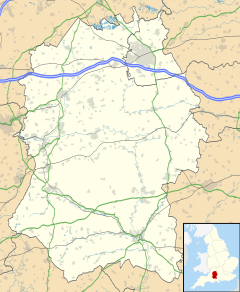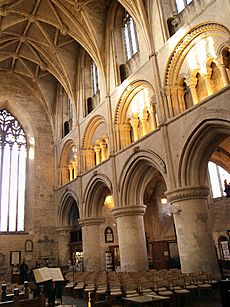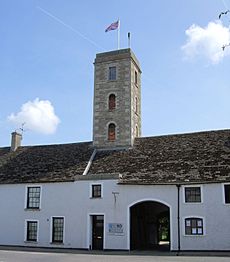Malmesbury facts for kids
Quick facts for kids Malmesbury |
|
|---|---|
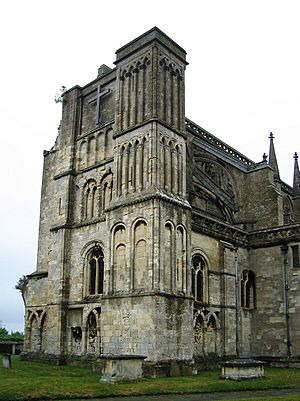 Malmesbury Abbey |
|
| Population | 5,380 (2011 census) |
| Demonym | Jackdaws (in informal contexts — blason populaire) |
| OS grid reference | ST940857 |
| Unitary authority |
|
| Ceremonial county | |
| Region | |
| Country | England |
| Sovereign state | United Kingdom |
| Post town | Malmesbury |
| Postcode district | SN16 |
| Dialling code | 01666 |
| Police | Wiltshire |
| Fire | Wiltshire |
| Ambulance | Great Western |
| EU Parliament | South West England |
| UK Parliament |
|
Malmesbury is a town and civil parish in Wiltshire, England. As a market town it became prominent in the Middle Ages as a centre for learning focused on and around Malmesbury Abbey, the bulk of which forms a rare survival of the dissolution of the monasteries. Once the site of an Iron Age fort, in the early medieval period it became the site of a monastery famed for its learning and one of Alfred the Great's fortified burhs for defence against the Vikings. Æthelstan, the first king of all England, was buried in Malmesbury Abbey when he died in 939.
History
The hilltop contains several freshwater springs, which helped early settlements. It was the site of an Iron Age fort, and in the Anglo-Saxon period it had a monastery famed as a centre of learning. The town is listed in the Burghal Hidage as one of Alfred the Great's defended burhs assessed at 1200 hides, its Iron Age defences helping to provide protection against Viking attack. The town was described in the Domesday Book as a borough. Alfred's grandson, Æthelstan, the first king of England, was buried in Malmesbury Abbey in 939.
Malmesbury Abbey

The Abbey was founded in 675 by Maildubh, Mailduf or Maelduib, an Irishman. After the death of Maidulph around 700, Aldhelm became the first abbot and built the first church organ in England, which was described as a "mighty instrument with innumerable tones, blown with bellows, and enclosed in a gilded case." Having founded other churches in the area, including at Bradford on Avon, he died in 709 and was canonised. Its architecture is listed in the highest category and it is a Scheduled Ancient Monument. Across the River Avon's Sherston branch via the footpath by 18 Gloucester Street (leading south-west) is a depression Daniels Well and a farm beyond it is named after this. This derives from a monk called Daniel named after earlier Daniel of Winchester. This former bishop, on losing his sight, lived at the abbey briefly until death in 745AD and was educated there. The later monk is said to have submerged himself in the cold water every day for decades to quell fiery passions. The Abbey was the site of an early attempt at human flight, when noted by historian William of Malmesbury (1095–1143) in 1010, the monk Eilmer of Malmesbury flew a primitive hang glider from a tower. Eilmer flew over 180 metres before landing, breaking both legs.
Thus by the time of the Norman invasion in 1066, Malmesbury was one of the most significant towns in England. It is listed first (i.e., most important) in the Wiltshire section of the Domesday Book. King Henry I's chancellor, Roger of Salisbury, seized the monastery under his bishopric in 1118, and held it for 20 years. Renowned as a great builder, he rebuilt the wooden town walls wholly in stone rather than wood, constructing Malmesbury Castle at the same time.
By the Dark Ages, the north of the town was heavily developed as a religious centre, resulting in the construction of the third Abbey on the site, the 12th century Malmesbury Abbey, which had a spire 7 metres (23 ft) taller than the 123 metres (404 ft) one of Salisbury Cathedral. In 1220 this resulted in the construction of the Abbey guest house, which is now The Old Bell hotel which claims to be the oldest hotel in England.
Malmesbury natives can be nicknamed Jackdaws, originating from the avian colony of these that inhabit the Abbey walls and roof.
Battles
The community was the ancient frontier of two kingdoms, with Tetbury 5 miles (8.0 km) to the north in Mercia while Malmesbury was in the West Saxon Kingdom, resulting in centuries of animosity between the two towns. The location and defensive position of Malmesbury on the latterly important Oxford to Bristol route made it a strategic military point. During the 12th century civil war between Stephen of England and his cousin the Empress Matilda, the succession agreement between Stephen and Henry of Anjou (later Henry II) was reached after their armies faced each other across the impassable River Avon at Malmesbury in the winter of 1153, with Stephen losing by refusing battle.
During the Civil War the town changed hands seven times, with the south face of Malmesbury Abbey still today bearing pock-marks from cannon and gunshot. In 1646 Parliament ordered that the town walls be destroyed. As peace came to inland England, and the need to defend the developing coastal port towns became more important, Malmesbury, without its Abbey, lost its importance. As developing transport and trade routes passed it by, it regressed to a regional market town.
Malmesbury Commoners
At the Battle of Brunanburh in 937, King Athelstan of Wessex defeated an army of northern English and Scots and made a claim to become the first 'King of All England'. Helped by many men from Malmesbury, in gratitude he gave the townsfolk their freedom, along with 600 hides of land to the south of the town. The status of freemen of Malmesbury was passed down through the generations and remains to this day. It is likely, however, that the title of freeman, or commoner, was given to tradesmen and craftsmen coming into the town during the early Middle Ages, so the claim of direct lineage from the men who fought with King Athelstan to the present day commoners is unlikely, though possible. Since at least the 17th century, however, the right has been only handed down from father to son or son-in-law. There is a maximum of 280 commoners. The organisation is said to be the 'most exclusive club' in the world, as to enter it one has to be born to a freeman or marry the daughter of one.
Since 2000, and with the possibility of falling numbers, women were admitted for the first time - the daughters of freemen. The organisation, The Warden and Freemen of Malmesbury, still owns the land to the south of the town, along with dozens of properties, pubs and shops within the town itself, providing affordable housing to townsfolk.
Geography
Malmesbury sits on a flat Cotswolds hilltop at the convergence of two rivers. From the west, the infant (Bristol) Avon flows from Sherston, and from the north west, a tributary either known as the Tetbury Avon, River Avon (Tetbury branch) or, locally, The Ingleburn. They flow within 90 metres (300 ft) of each other but are separated by a narrow and high isthmus, just a few metres across, which forces the Bristol Avon south and the Tetbury Avon east. This creates a rocky outcrop as a south-facing, gently sloping hilltop, until the two rivers meet on the southern edge of the town. With steep, and in places cliff-like sides, the town was described by Sir William Waller, as the best naturally-defended inland location he had seen.
Demography
In 2011 the population reached 5,380 living in 2,280 homes. The additional figures are given for The Abbey, the supplemental ecclesiastical parish added to that of St Paul when this existed. Figures from 1911 are for metropolitan borough and after 1961 for ward. For 1901 the area was split into three respective parishes, St Paul Within, St Paul Without and Abbey so three figures are given in the correct order as stated.
| Year | 1801 | 1811 | 1821 | 1831 | 1841 | 1851 | 1881 | 1891 | |
|---|---|---|---|---|---|---|---|---|---|
| Population | 1,491 + 80 | 1,609 + 137 | 1,976 + 169 | 2,169 +124 | 2,367 + 131 | 2,443 + 138 | 2,220 + 150 | 2,144 + 119 | |
| Year | 1901 | 1911 | 1921 | 1931 | 1941 | 1951 | 1961 | 2001 | 2011 |
| Population | 1,181 + 974 + 106 | 2,656 | 2,407 | 2,334 | 2,464 | 2,510 | 4,631 | 2,610 | 5,380 |
Culture and community
Malmesbury has a thriving carnival, which takes place in the last two weeks of August, with the finale procession through the town held on the first Saturday in September. It has grown in recent years to now include more than 30 events, ranging from music events to an attempt on the world record for the largest pillow fight.
The world music festival Womad Charlton Park has been held in Charlton Park near Malmesbury since 2007.
Sport and leisure
Malmesbury has a non-League football team Malmesbury Victoria F.C., who play at The Flying Monk Ground. A swimming club, 'Malmesbury Marlins', train at The Activity Zone leisure centre. Malmesbury Cricket Club are an ECB Clubmark accredited sports club who play at The Wortheys sports ground, with adult and junior teams playing in the Wiltshire Leagues.
Planning
In 2011 Malmesbury was chosen by the Department for Communities and Local Government as a "front-runner" area to test Neighbourhood Planning powers introduced in the Localism Act 2011. As part of the neighbourhood planning process in February 2012 a series of seminars and workshops involving residents and stakeholders were run in Malmesbury by The Prince's Foundation for Building Community. In March 2012 issues of planning in Malmesbury were featured as part of the wider national debate about changes to the planning system and the balance of power between communities and developers.
Landmarks
What made Malmesbury successful as a town - water and excellent defences - led to both its current layout and the reason that it still retains over 400 listed buildings within its boundaries. Although Roger of Salisbury reconstructed the town after his accession to Bishop of Salisbury in 1102, the Saxon layout he rebuilt is still retained in the centre today. However, the geography also precluded easy development for mass transport and hence hindered industrial development, leaving the architecture and ancient buildings largely untouched. The result is a higher proportion of Grade I and Grade II buildings than in many other English towns. It also has a WW2 era pillbox, in a field near to David Hendry Cars at Filands.
Market Cross
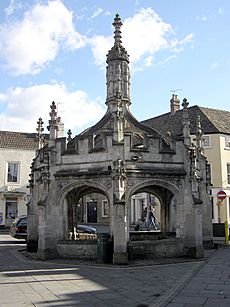
In the centre of the town stands the market cross, built c. 1490, possibly using stone salvaged from the recently ruined part of the abbey. It was described by John Leland, writing in the 1540s, as a 'right costly piece of work', which was built to shelter the 'poore market folke' when 'rain cometh'. An elaborately carved octagonal structure, it is recognised as one of the best preserved of its kind in England. It still serves its purpose today, nicknamed 'The Birdcage', because of its appearance, it shelters market traders by day and as a meeting point at night.
Numbers 1 and 3 Market Cross are listed buildings, as is the former Abbey Brewery opposite.
Tower House
A large building of medieval origins, now a private home, Tower House stands at the end of Oxford Street. It contains a high-roofed main hall where it is said Henry VIII dined after hunting in nearby Bradon Forest. In the 1840s, a doctor living in the house, with a passion for astronomy, built a narrow tower protruding high from the roof. It dominates the skyline of the east of the town. The tower now sports a flag pole and flies the union flag (as photo) and sometimes St. Aldhelm's flag.
Bremilham Church
Near the town lies Bremilham Church, located on Cowage Farm, Foxley-cum-Bremilham, which measures just 4 m by 3.6 m. Its single pew has space for four people and there is standing room for six more. The church, which is listed in the Guinness Book of Records as the smallest church in use in Britain, holds an annual service to mark Rogationtide. The church can be found by heading west from Malmesbury along Foxley Road.
Transport
Malmesbury railway station opened on 17 December 1877. The Malmesbury branch was built largely by the Malmesbury Railway Company, and was completed by the Great Western Railway which absorbed the Malmesbury Railway Company in May 1877 when the latter could not raise sufficient funds to complete the line. The branch split from the main London-Bristol line at Dauntsey, although a later connection with the northern GWR 'mainline' to the Severn Tunnel and South Wales was made at Little Somerford. Just short of its terminus, the line ran through a short tunnel: the only tunnel on the line between Malmesbury and Paddington. The station closed to passengers in 1951 (their last day was 8 September), and freight in 1962. The tracks were used for a period to test new diesel locomotives built by Swindon railway works, but lifted in the 1970s, and the site of the station is now an industrial estate.
The nearest stations today, all managed and served by Great Western Railway, are:
- Kemble on the Golden Valley Line
- Chippenham on the Great Western Main Line
- Swindon on the Great Western Main Line
The town's bus network is run by Coachstyle, who run a town service in addition to services to and from Swindon, Yate, Chippenham and Cirencester.
Twin towns – Sister cities
Economy
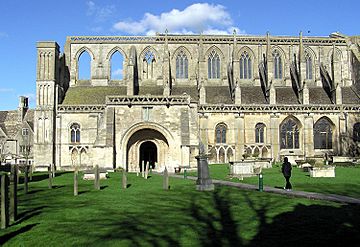
Traditionally a market town serving the rural area of north west Wiltshire, farming has been the main industry. Even today, the High Street has numerous independent shops and a weekly market. The Reformation of 1539 brought about a change in the economy of Malmesbury: having no income from the Abbey, the town turned to the wool spinning and weaving industry, having access to large quantities of wool and water. It then became a centre of the lace-making industry. But, what had made it successful and important as a religious and strategic defensive centre – water on three sides and steep cliffs – precluded easy access for the modern bulk transport methods of canals and railways. Hence the Kennet and Avon Canal and the later Great Western Railway passed well to the south of the town; while local quarrying of cotswold stone provided often transient booms in employment, Malmesbury saw little expansion compared to, for example, Gloucester, by not being a commuter suburb or major production centre of the industrial revolution.
The town's main employer today is Dyson, which has a site on the edge of the town where it employs around 4,000. This is mainly a research, development and design organisation, with manufacturing carried out in Malaysia. The site was the company's headquarters until 2019, when it was announced that the company registration would be moved to Singapore.
The town's economy profits from tourism, divided among Cotswold Hills retreats (ranging from B&Bs to golf/spa resorts), visits and tours of the abbey, nearby landmarks and festivals or by interest in the counter-modernism 1960s work of poet laureate, John Betjeman.
Malmesbury had a nine-day wonder media event in January 1998, when two Tamworth pigs known as the Tamworth Two escaped from the town's abattoir. They swam the Tetbury branch of the River Avon, across a few fields and lived in an orchard for a week. The story made international headlines with tabloid newspapers and TV news stations fighting each other to sight and then capture the pigs. The pigs were recaptured, and lived out their lives in an animal rescue centre.
EKCO factory
At the beginning of the World War II, the electronics company EKCO moved part of its operations from Southend-on-Sea to Cowbridge House, 3⁄4 mile (1.2 km) southeast of the town, to avoid the danger of bombing. The company established a shadow factory to produce radar equipment, then a new technology. The factory continued production after the war, was taken over by Pye TMC and then Philips, and later became part of AT&T. The site was in use as offices until 2004 when the owners, Lucent Technologies, moved their operations to Swindon and the building was converted to housing.
Education
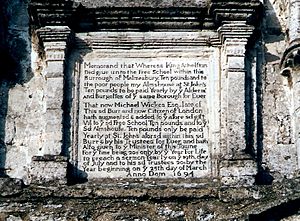
Malmesbury has two primary schools – Malmesbury Church of England Primary School and St. Joseph's Roman Catholic Primary School – and a secondary school, Malmesbury School.
Notable people
For a full list, see: Category:People from Malmesbury
- King Athelstan – first king of all England
- Eilmer of Malmesbury – Benedictine monk best known for his early attempt at a gliding flight using wings
- Saint Aldhelm – Saxon scholar, bishop, poet, musician; patron saint of Wessex and the abbey's first abbot
- Thomas Hobbes – prominent British philosopher
- John Luce, senior Royal Navy officer
- William of Malmesbury – historian
- Hannah Twynnoy – barmaid; reputedly the first person killed by a tiger in Britain
- James Constable – footballer
- James Scott Douglas – racing driver and the 6th Baronet Douglas
- Roger Scruton – philosopher
- Basil Reed – cricketer
Images for kids
-
Malmesbury and Westport from the Ordnance Survey one-inch map, first edition, 1828
See also
 In Spanish: Malmesbury para niños
In Spanish: Malmesbury para niños


